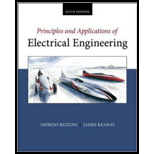
Concept explainers
The current through a 0.8-H inductor is given by
The expression for the voltage across the inductor.
Answer to Problem 4.1HP
The expression for the voltage across the inductor is
Explanation of Solution
Calculation:
The expression for the voltage across the inductor is given by,
Substitute
Conclusion:
Therefore, the expression for the voltage across the inductor is
Want to see more full solutions like this?
Chapter 4 Solutions
Principles and Applications of Electrical Engineering
- A capacitor uses air as a dielectric and has a capacitance of 3 F. A dielectric material is inserted between the plates without changing the spacing, and the capacitance becomes 15 F. What is the dielectric constant of this material?arrow_forwardThree capacitors having capacitance values of 20F,40F, and 50F are connected in parallel to a 60 - Hz power line. An ammeter indicates a circuit current of 8.6 amperes. How much current is flowing through the 40F capacitor?arrow_forwardA pure inductance of L 144 mH is connected to a V = 112 V, 50 Hz supply. The current taken by the inductor is given byarrow_forward
- how do i calculate the inverse capacitance and its uncertainty if the capacitance value 1.8748+/- 0.0006. please show steps im using this example to do my other values.arrow_forwarda 20mH inductor draws a current of i(t) = 100 sin(100t). Find the voltage %3D equation 200 sin100t 200 cos100t 2000 sin100t 2000 cos100tarrow_forwardA paralel-plate capacitor is constructed using a dielectric material whose dielectric constant is 2.40 and whose dielectric strength is 3.00 x 10" wm. The desired capacitance is 0.100 g, and the capacitor must withstand a maximum potential difference of 4.00 kv. Find the minimum area of the capacitor plates. Jm²arrow_forward
- SOlve for the equivalent inductance Lt.arrow_forwarda) The current through a 0.025 H inductance is i = 50 Sin (@t – 60°) A and frequency equal to 50 Hz. Determine the voltage across the inductor and draw the phasor diagram. b) Define the time period. |arrow_forward. An inductance of 15mH has a current drawing I = 15sin(650t - 300) A. Determine the equation of voltage in the circuitarrow_forward
- 1. What impedance vector 0 – j22 represents:A. A pure resistance.B. A pure inductance.C. A pure capacitance.D. An inductance combined with a resistance.arrow_forwardFind the equivalent inductance of the circuit shown in the image below. Assume all inductors are 80 mH. ell ell ell The equivalent inductance of the circuit is mH.arrow_forward1) First part of the question: Two identical capacitors are connected in parallel and charged with a 20-V power supply as shown in the figure on the left. After the charges on the capacitors have reached their final values, the charge on each capacitor is 10 µC. Then the power supply is disconnected and a dielectric with K = 4 is inserted to fill the space between the plates of one of the capacitors. a) Find now the charge on the capacitor with dielectric. Give your answer in microcoulombs. Qo = 10 µC Qo = 10 µC| Q2 =? ► V = 20 V Batteryarrow_forward
 Delmar's Standard Textbook Of ElectricityElectrical EngineeringISBN:9781337900348Author:Stephen L. HermanPublisher:Cengage Learning
Delmar's Standard Textbook Of ElectricityElectrical EngineeringISBN:9781337900348Author:Stephen L. HermanPublisher:Cengage Learning
